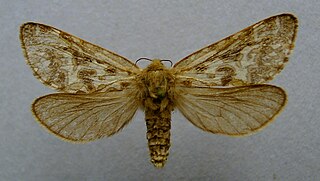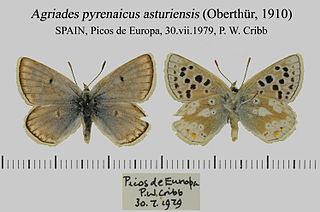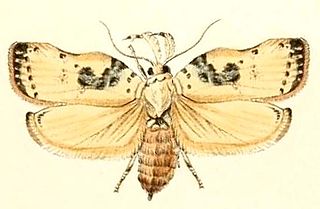
The Hepialidae are a family of insects in the lepidopteran order. Moths of this family are often referred to as swift moths or ghost moths.

The desman, a snouted and naked-tailed diving insectivore of the tribe Desmanini, belongs to one of two Eurasian species of the mole family, Talpidae.

The Pyrenean desman also called Iberian desman is a small semiaquatic, globally threatened mammal related to moles and shrews, and, along with the Russian desman , is one of the two extant members of the tribe Desmanini. The species occurs in north and central parts of Spain and Portugal, French Pyrenees, and Andorra, but severe range contractions have been documented across its geographic distribution.

Pharmacis is a genus of moths of the family Hepialidae. There are eight described species found in Eurasia.

Leontodon pyrenaicus is a species of hawkbit found in the Alps, Pyrenees, Cantabrian Mountains, northern Apennines and northern parts of the Balkan Peninsula. It grows in meadows and on stony slopes from the tree line to over 3000 m, usually on acidic soils. It is perennial, and flowers from June to August.

The map-winged swift is a moth belonging to the family Hepialidae and has a patchy distribution throughout Eurasia. The species was first described by Charles De Geer in 1778. It was previously placed in the genus Hepialus and some references still place it there.

Eugnosta is a genus of moths belonging to the family Tortricidae.

Pharmacis carna is a moth of the family Hepialidae. It is mainly found in mountainous areas, mostly in the Alps and the Carpathian Mountains, although it is also present in Hungary.
Coleophora nubivagella is a moth of the family Coleophoridae. It is found from Germany and Poland to the Pyrenees, Italy, North Macedonia and Romania.

Pharmacis aemilianus is a moth of the family Hepialidae. It is known from Italy.
Pharmacis anselminae is a moth of the family Hepialidae. It is known from Italy.
Pharmacis bertrandi is a moth of the family Hepialidae. It is known from France and Italy.
Pharmacis castillanus is a moth of the family Hepialidae. It is known from Spain.
Pharmacis claudiae is a moth of the family Hepialidae. It is known from Italy.

Agriades pyrenaicus, the Gavarnie blue, is a Palearctic butterfly of the family Lycaenidae. It is found in the Asturias mountains of north-western Spain, the Pyrenees, the southern Balkan Peninsula, Turkey, the Caucasus and Armenia. The habitat consists of alpine grassy rocky meadows where it is found at altitudes ranging from 1,500 to 2,200 meters.

Tonica is a genus of moths of the family Depressariidae.
Tonica pharmacis is a moth in the family Depressariidae. It was described by Alexey Diakonoff in 1966. It is found on Sumatra.
Hugues-Fleury Donzel was a French entomologist specialising in butterflies and moths.

The Noisetier Cave, owing its popular name to the Hazel trees that grow in front of its entrance, is located in a mountainside 145 m (476 ft) atop the Vallée d'Aure in the Ardengost commune, Hautes-Pyrénées department in the region Occitania, Southern France. During systematic excavations since 1992 Middle Paleolithic stone tools and artifacts attributed to the Neanderthal Mousterian culture were discovered among numerous faunal remains.
Mimomys is an extinct genus of voles that lived in Eurasia and North America during the Plio-Pleistocene. It is believed that one of the many species belonging to this genus gave rise to the modern water voles (Arvicola). Several other prehistoric genera of vole are probably synonymous with Mimomys, including the North American Cosomys and Ophiomys.











